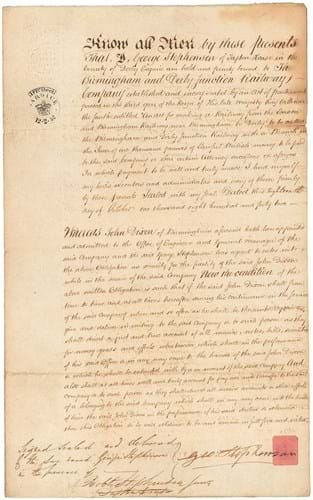
The 1842 contract signed by railway pioneers including George and Robert Stephenson and John Dixon – $15,000 (£11,500) at Roland & Co.
Exactly how a contract uniting three pioneers of the British passenger railway system made its way to the US was unknown. But it came for sale at the Southport, Connecticut, saleroom of Roland & Co on February 12 from a vendor who had bought it at an RM Smythe auction in New York some years ago.
The auction house, which specialises in autographs, manuscripts and ephemera, thought it might be worth at least $250-450 and it was right – it sold to a buyer from outside the US for $15,000 (£11,500) plus buyer’s premium.
In this handwritten legal document, of October 18, 1842, George Stephenson of Tapton House, Derbyshire agrees to put down a bond of £1000 to guarantee the faithful performance of the services of Mr John Dixon as the engineer and general manager of the Birmingham & Derby Junction Railway.
It is inscribed Signed sealed and delivered by the above named George Stephenson in the presence of Robert Stephenson Jnr, Tapton House.
While George and his son Robert, the men behind The Rocket, scarcely need an introduction, John Dixon (1796-1865) is a lesser-known but almost equally important name in the early history of the railways.
Born into a County Durham family of Quaker industrialists, he began his working life clerking for Jonathan Backhouse (1747-1826), the Darlington banker who helped finance the Stockton & Darlington Railway project. However, as George Stephenson’s assistant, Dixon would prove himself a brilliant surveyor and civil engineer.
Following the opening of the S&DR, the world’s first passenger railway using steam locomotives, in 1825 Dixon oversaw the surveying work on the Liverpool and Manchester line (the first public inter-city railway opened in 1830) and a succession of other projects in the 1830s-40s.
Businessmen in Birmingham, well served since the 18th century by an extensive canal network, began looking at the possibilities of the iron horse in the 1830s. With the support of Prime Minister Robert Peel, the MP for Tamworth, the Birmingham & Derby Junction Railway Bill passed through Parliament in 1836. Robert Stephenson took on the post of engineer to oversee the construction of 42 miles of track, 78 bridges, two viaducts and a cutting approaching Derby.
The B&DR opened on August 12, 1839, with Dixon assuming his role three years later. It appears he was in the post until 1845 when he returned to Darlington to work at the S&DR.
Roland & Co is the successor to RM Smythe & Co, a New York auction house established in 1880.














